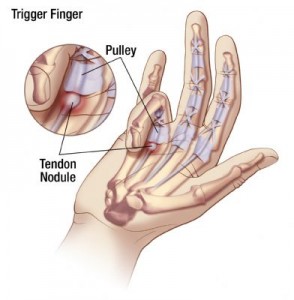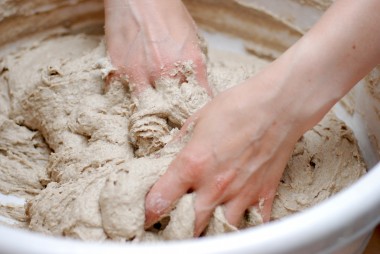Colles Wrist Fracture
A Colles fracture is a break across the end of the radius, that main bone of the forearm. This type of injury causes the wrist to become shortened and extended. Other names for the Colles fracture are transverse wrist fracture or dinner-fork deformity. These types of fractures occur commonly when the arm is outstretched to break a fall. This injury is more likely to happen during skateboarding, rollerblading, running or some other sports activity in which a forward fall occurs while the person is moving at high speed.
Most of these types of fractures can be placed in a splint and an arm sling. Sometimes, a lightweight, fiberglass cast is necessary. If the bone is no longer in line and straight, the fracture may need to be ‘reduced’ or straightened by way of wrist surgery. The Orthopedic Specialist will use a local anesthesia before reducing this type of fracture.
In some cases, surgery is warranted. The break may need to be fixed with wrist surgery using a plate, screws, pins, or other metal hardware. Some surgeons can use plastic hardware, too.
What are the Symptoms of a Colles Fracture?
This type of fracture changes the shape and angle of the forearm in the area just above the wrist. The injured person will have pain and inability to hold objects. Most always, a Colles’ fracture causes swelling just above the wrist and the person is unable to lift with that hand.
What is the First Aid for a Colles Fracture?
- Place the wrist and hand in a splint in normal position.
- Place a rolled up sock in the palm and wrap the hand and wrist area with an elastic bandage.
- Use an ice pack to reduce swelling.
- Go to the emergency room or your Orthopedic Specialist’s office.
- Do NOT try to move or straighten the hand and wrist.
What Can the Orthopedic Specialist Do?
- Stabilize the fracture.
- Order X-Rays and other scanning tests.
- Reduce the fracture if necessary.
- Perform wrist surgery on the fracture if necessary.
- Prescribe a rehabilitation plan to prevent deformity.
Hand Fractures
The hand is made up of many small bones, and these bones work together as the supporting framework. A fracture occurs whenever there is enough force applied to one of the bones. When a fracture occurs, there is pain, decreased range of motion, and swelling. These could be simple or complex, depending on what part is injured. Some fractures happen in the main body of the bone known as the shaft. Others occur on the joint surface. A comminuted fracture is when the bone is shattered into many pieces and this is from a high energy impact. An open fracture is called a compound fracture, and this is when a piece of the bone comes through the skin.
How does Fractures Affect the Hand?
A fracture can cause stiffness, loss of movement, and pain of the hand. Some will cause a deformity, such as a crooked finger, too. Many fractures of the hand are painless and no deformity develops. Fractures can injure a joint surface and this will lead to arthritis.
What Can the Orthopedic Specialist Do?
- Order a medical evaluation with X-Rays.
- Provide a splint or cast
- Perform hand surgery by open reduction or closed reduction and internal fixation (surgery).
- Prescribe a specialized rehabilitation plan.
Wrist Sprains and Strains
One of the most common causes of wrist pain in athletes is a sprain of the wrist. A wrist sprain generally occurs after a fall on an outstretched hand stretches or tears the ligaments of the wrist. Common causes of wrist sprains include falls during sports such as inline skating, skiing, snowboarding, skateboarding, soccer, football, baseball, and volleyball.
When an athlete falls on the outstretched hand, the muscles, tendons and ligaments in the wrist take the brunt of the impact, and can be stretched and perhaps torn. If these tissues are inflexible or fragile, the risk of injury intensifies. Basically, a sprain is an injury to a ligament. Ligaments are the tough, fibrous tissues that connect bones to other bones.
A strain results when a muscle or tendon is injured. Tendons are the structures that connect muscles to bones. This can occur when the athlete falls on an outstretched hand, much like a sprain. Strains result when there is overstretching of the muscle, also. Mild strains of the wrists are not as severe as sprains of the wrist. However, strains that are severe result in complete tears of the tendon and muscle tissue and these are quite painful.
Symptoms of Sprains and Strains of the Wrist
With a wrist sprain, there is pain, tenderness, and swelling over the wrist after the fall. It often is tender, red, and warm to the touch, too. With a strain, there may be bruising, decreased range of motion, and a deep dull ache in the wrist area. If you suspect you have either of these conditions, you should seek medical attention. Some strains require wrist surgery.
Solutions for Sprains and Strains
The first line medical treatment involves the R.I.C.E. formula. This includes:
Rest – If you have an injury, stop activity and don’t use the injured wrist for 48 hours or until your doctor says it is OK. Wait for sure until the pain and swelling has subsided.
Ice – Apply ice to the wrist by means of a cold pack (ice wrapped in a towel) or a bag of peas from the freezer. Do this for around 20 minutes, off for 20, then back on again for 20. Continue this until swelling subsides.
Compression – Use an elastic compression bandage (commonly known as an ACE wrap) to secure the wrist and limit swelling. Start the wrap at the base of the fingers and stop just below the elbow. The wrap should be snug, but be careful not to wrap it tight and cut off circulation to the fingers.
Elevation – Keep the injured wrist higher than your heart as often during the day and at night for the first 48 hours after the injury. You can do this with an arm sling or elevating it on pillows. This will help drain fluid and reduce swelling that may form around the wrist.
Tendonitis
Tendonitis of the wrist is simply irritation and swelling that occurs to the tissue. The area affected where the ‘tunnel’ occurs is the tissues around the thumb. The most common symptom is pain in the front of the wrist and pain with bending and extending of the wrist. Mild swelling that is visible often occurs, as well.
Tendonitis of the wrist is caused by injury to the arm, over use, biomechanical problems, and poor equipment operation. Sometimes, when someone begins a new activity or exercise, tendonitis will flare up.
Treating Tendonitis
If detected and treated early, tendonitis will improve quickly. The Orthopedic Specialist may give you steroid injections or an anti-inflammatory medication. More serious tendonitis requires hand surgery and wrist surgery, but this is rarely the case. If you feel that you have this condition, rest the wrist and do the R.I.C.E. therapy for a few days.

 Trigger finger is a common condition that results in pain and snapping of the tendons at the base of the finger or thumb. These tendons are like pulleys that attach to the ends of the fingers to allow for finger movement. As the forearm muscle contracts, the tendons pull each finger into a fist. With trigger finger, this mechanism is not smooth and a snapping sensation can be felt, causing pain.
Trigger finger is a common condition that results in pain and snapping of the tendons at the base of the finger or thumb. These tendons are like pulleys that attach to the ends of the fingers to allow for finger movement. As the forearm muscle contracts, the tendons pull each finger into a fist. With trigger finger, this mechanism is not smooth and a snapping sensation can be felt, causing pain. The word “arthritis” simply means “joint inflammation.” Inflammation involves pain, swelling, and stiffness of the joint area. When arthritis occurs, these symptoms tend to last for a long periods of time or reoccur over time.
The word “arthritis” simply means “joint inflammation.” Inflammation involves pain, swelling, and stiffness of the joint area. When arthritis occurs, these symptoms tend to last for a long periods of time or reoccur over time. 